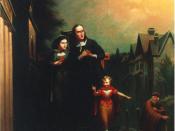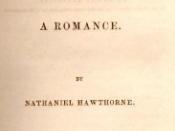The scarlet letter is Hester's passport into regions where other women dare not to tread for fear of being ostracized by the Puritan community. This is one symbol used in The Scarlet Letter to illustrate how society affects individuals' actions and beliefs. Some symbols have a greater impact than others because they hold a deeper, more direct meaning. Through the use of symbols, such as the scarlet letter, the scaffold, and Pearl, Nathaniel Hawthorne makes the conflicts between individuals and society more apparent by proving the superiority of natural law.
Symbols are used throughout the novel to create a deeper understanding of human nature's role in societal judgments. Symbols such as the scarlet letter and the scaffold hold multiple meanings, while others, like Pearl and the rosebush, repeat their singular meaning throughout the novel. Pearl, who claims to be "plucked by her mother off the bush of wild roses that grew by the prison-door," represents Hester and Dimmesdale's love and shame (76).
This bush of wild roses is used to represent the "sorrow and human frailty" caused by their act of love (34). Pearl can also be considered an example of sorrow and human frailty since she is also a "emblem and product of sin" (64). The scarlet letter, on the other hand, changes meaning from "its original signification [of Adultery]" to "Able, [because] Hester Prynne was, with a woman's strength, so strong" (111). At times it almost means 'Honor', foreign "bond-servant[s], perhaps judging from the glittering symbol in her bosom, [believed] that she was a great lady in the land" (71). The scaffold is used by society to represent their system of justice and way of punishment, while, for Dimmesdale, it is portrayed as a place of redemption, or where he can go to obtain salvation and 'get away'...



Awesome!
I have to write a paper on the Scarlet Letter in a few weeks and something you said in here gave me a great idea for a thesis statement! Thanx! :)
2 out of 2 people found this comment useful.